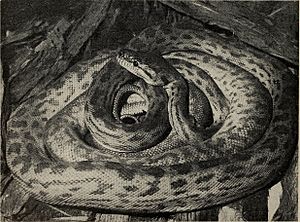Oenpelli python facts for kids
Quick facts for kids Oenpelli python |
|
|---|---|
 |
|
| Conservation status | |
| Scientific classification | |
| Genus: |
Nawaran
|
| Species: |
oenpelliensis
|
| Synonyms | |
|
|
The Oenpelli python is a very large snake that belongs to the python family. Its scientific name is Nawaran oenpelliensis, but it was once known as Morelia oenpelliensis. This special snake lives only in the sandstone areas of western Arnhem Land in the Northern Territory of Australia.
It is one of the rarest pythons in the world. The Oenpelli python has two cool features: its eggs are super big, and it can actually change its skin color!
Contents
About the Oenpelli Python
How Scientists Named This Snake
The Oenpelli python was first given its scientific name in 1977 by a scientist named Graeme Gow. He put it in the group called Python. Later, other scientists moved it to different groups, like Morelia and Simalia.
Today, scientists mostly agree that this python belongs to its own special group, or genus, called Nawaran. The name oenpelliensis comes from the place where it was first found, which is near a town called Oenpelli in the Northern Territory of Australia.
What Does the Oenpelli Python Look Like?
The Oenpelli python is a very large and rare snake. It can grow to be more than 4 meters (about 13 feet) long! One python kept by people was even reported to be over 5 meters (about 16 feet) long.
Even though it's very long, it's quite thin compared to other pythons. Its back is usually dark olive-brown with darker spots. Its belly is a pale, dull color, from cream to yellow.
A really cool thing about the Oenpelli python is that it can change its skin color. It tends to be lighter at night and darker during the day.
The eggs of the Oenpelli python are huge! They can be about 110.5 by 60 millimeters (about 4.3 by 2.3 inches). This is almost twice the size of eggs from a similar snake, the amethystine python.
Life and Habits of the Oenpelli Python
How It Behaves
The Oenpelli python is nocturnal, which means it is active mostly at night. During the day, it likes to hide in rock cracks, trees, and caves.
It eats birds that are feeding in fruit trees. Scientists think it might even specialize in eating birds. Adult pythons also hunt medium to large mammals, like possums or large kangaroos and wallabies. Pythons kept by people eat birds and rodents.
This snake is an ambush predator. This means it stays very still for a long time, waiting for its prey to come close before it strikes.
Where It Lives
The Oenpelli python lives in a small area of the Northern Territory in Australia. You can find it in the rocky sandstone areas of western Arnhem Land.
It prefers to live in places with sandstone rocks, especially near the upper parts of the Cadell, South Alligator, and East Alligator rivers. It likes to roam between different spots, such as rocky overhangs, caves in sandstone gorges, or shady trees. People have also seen it in woodlands, heathlands, and open rocky plains in the area. It is often found near sandstone rock outcrops that have thick plants growing around them.
Protecting the Oenpelli Python
Conservation Status
Scientists don't know exactly how many Oenpelli pythons are left. It's hard to study them because the area where they live is very difficult to reach. This inaccessibility might actually help protect the species.
The government of the Northern Territory says the Oenpelli python is vulnerable to extinction. This means it's at risk of disappearing forever.
There are several reasons why this snake is in danger:
- Changes in land use and fires: How people use the land and how often fires happen can harm the python's home.
- Fewer prey animals: As a large predator, the python needs big animals to eat. If these animals become rare because of changes to their habitat or new animals brought in by people, the python struggles to find food.
- Limited habitat: There aren't many places left that are perfect for the Oenpelli python to live.
- Illegal collection: Some people try to catch these snakes illegally to keep them as pets. This can hurt the wild population.
The good news is that the Oenpelli python lives inside a protected area called Kakadu National Park. Also, a special program to breed these pythons was started in 2012. By early 2015, the first two baby pythons were born in captivity, which is a big step towards helping the species survive!
In Aboriginal Language and Culture
In the Kunwinjku language, which is spoken by the Aboriginal people in the Oenpelli area (now called Gunbalanya), the python is known as nawaran.
The Oenpelli python has always been an important animal for the Bininj Aboriginal people. It is a totemic creature, which means it has a special spiritual meaning for them. Because its scales can look shiny and colorful, it might also be connected to the Rainbow Serpent, a very important figure in Aboriginal stories.
- Nawaran oenpelliensis at the TIGR Reptile Database. Accessed 15 January 2021.
- "Darwin snake expert breeds 'rainbow serpent' python back from the brink of extinction." ABC News 14 April 2015. [1]


